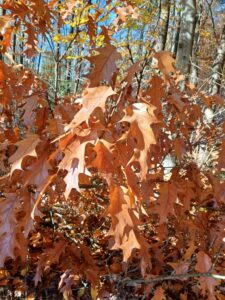The Mighty Oaks

By Kate Carnahan, Outdoor Recreation Specialist Individual Placement / AmeriCorps Member placed at Minnesota Department of Natural Resources, Division of Parks and Trails.

As the air cools and our drinks become warmer, I would like to invite all of you to take a look outside your window and observe your surrounding trees. Depending on where you are in the state, trees might only be woody trunks sticking out of the ground surrounded by piles of leaves. Others might be able to see spectacular reds and oranges brightening up the area. And some of you may just see the same view of conifers that you did in the summer for miles to come. However, one tree that sticks out and will continue to stick out are the ones with crumpled, brown leaves still attached to the tree. These are the oaks.

Oak trees are famously one of the most beloved trees in deciduous forests across the world. They command strength, power, and endurance with their long, entangled branches and sturdy trunks. In some cultures, oaks trees even represent the center of the world. Nowadays, oak trees can be seen as a nuisance to roads, sidewalks, and underground plumbing as their roots continue to spread outwards despite the infrastructure that has taken over the space. Nevertheless, these special trees are vital to supporting communities of mesofauna, fungi, insects, invertebrates, and more!

A key feature used to identify oaks in the winter is the brown leaves that seem to stick with them for most of our cold winters. Although scientists aren’t entirely sure why some oaks do this, a theory is that it’s to protect themselves from deer browsing and the dry winds of winter (Kortebein). Once oaks do drop their leaves, the leaf litter returns another of wave of much needed nutrients into the soil system that hadn’t received any since the usual fall leaf drop (Tallamy).
As the climate starts to change, oaks are also being used to remediate carbon emissions. One tree can absorb up to 10 pounds of air pollution in a year. Combine this with the oak’s long lifespan and they can absorb hundreds of pounds of air pollution (USDA). Additionally, oaks reduce ground surface temperatures, provide shading for houses and people, and supply food sources for local wildlife.
However, an issue that oaks have been battling with since the 1940s is oak wilt, which is a fungus-caused disease that travels between root systems underground as well as through beetles attracted to the fungus in spore mats underneath the tree bark. Identifying the disease can be tricky, with professionals using four primary ways to diagnose: leaf symptoms, tree mortality occurrences, fungal mats, and lab tests. This disease tends to affect red oaks in particular, while white oaks are less susceptive and can even survive if treated early enough. To avoid killing these species, avoid pruning oaks from April through July and if pruned, apply a spray or paint on the wound immediately after to create a barrier (Wisconsin Department of Natural Resources).

Moving forward, it’s important to acknowledge the value and significance of the oak species in the wild and in populated areas. Through the protection of this ancient species, we can work towards protecting our world and moderating our carbon emissions.
Sources:
Creating Climate Resilient Oak Forests in Cities. US Forest Service Research and Development. (1AD).
Wisconsin Department of Natural Resources. (n.d.). Oak Wilt. Oak Wilt | | Wisconsin DNR.